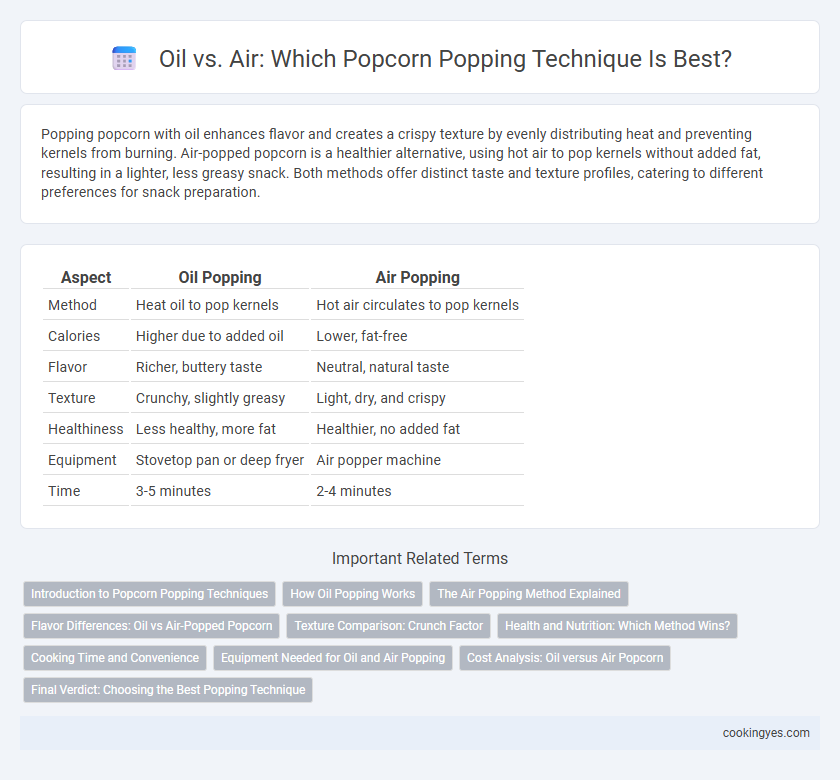Popping popcorn with oil enhances flavor and creates a crispy texture by evenly distributing heat and preventing kernels from burning. Air-popped popcorn is a healthier alternative, using hot air to pop kernels without added fat, resulting in a lighter, less greasy snack. Both methods offer distinct taste and texture profiles, catering to different preferences for snack preparation.
Table of Comparison
| Aspect | Oil Popping | Air Popping |
|---|---|---|
| Method | Heat oil to pop kernels | Hot air circulates to pop kernels |
| Calories | Higher due to added oil | Lower, fat-free |
| Flavor | Richer, buttery taste | Neutral, natural taste |
| Texture | Crunchy, slightly greasy | Light, dry, and crispy |
| Healthiness | Less healthy, more fat | Healthier, no added fat |
| Equipment | Stovetop pan or deep fryer | Air popper machine |
| Time | 3-5 minutes | 2-4 minutes |
Introduction to Popcorn Popping Techniques
Popcorn popping techniques primarily involve oil popping and air popping, each affecting texture and flavor. Oil popping uses heated oil to evenly distribute heat, producing a richer taste and crispier kernels, while air popping relies on hot air circulation, creating a lighter, lower-calorie snack. Understanding the differences in these methods helps consumers choose the best technique for their dietary preferences and desired popcorn quality.
How Oil Popping Works
Oil popping works by heating the oil to a high temperature, which transfers heat evenly to the popcorn kernels, causing the moisture inside each kernel to vaporize and create pressure that makes the kernel explode. The oil's high heat capacity and distribution help achieve a uniform pop and enhance flavor and texture by coating the popcorn evenly. Different oils, such as coconut or canola, impact the taste and caloric content, making oil popping a popular method for rich, flavorful popcorn.
The Air Popping Method Explained
The air popping method for popcorn uses hot air circulation to heat kernels evenly without the need for oil, resulting in a lower-calorie snack free from added fats. This technique preserves the natural flavor and crunch of popcorn while reducing the risk of burning or uneven popping often associated with oil-based methods. Advanced air poppers can produce up to 18 cups of fluffy popcorn in minutes, making air popping a healthier and efficient choice for snack preparation.
Flavor Differences: Oil vs Air-Popped Popcorn
Oil-popped popcorn offers a richer, buttery flavor due to the oil's ability to carry and enhance seasonings, creating a crispier texture. Air-popped popcorn delivers a lighter, more natural taste with fewer calories but often lacks the depth and mouthfeel provided by oil. Taste preferences vary, as oil imparts a savory richness while air-popping highlights the pure corn flavor.
Texture Comparison: Crunch Factor
Oil-popped popcorn has a richer, crunchier texture due to the fat coating each kernel, which enhances crispness and prevents sogginess. Air-popped popcorn tends to be lighter and less dense, offering a dry and slightly brittle crunch. The oil method delivers a more satisfying crunch factor preferred by many for its fuller mouthfeel.
Health and Nutrition: Which Method Wins?
Air-popped popcorn contains significantly fewer calories and less fat compared to oil-popped versions, making it a healthier choice for weight management and heart health. The absence of added oils reduces saturated fat intake, lowering the risk of cardiovascular diseases and supporting cholesterol control. Nutrient retention is higher in air-popped popcorn, preserving antioxidants such as polyphenols, which contribute to better overall nutrition.
Cooking Time and Convenience
Air-popped popcorn typically cooks faster, taking about 3-5 minutes, while oil-popped popcorn may require 4-6 minutes due to heat distribution. Air popping offers greater convenience by eliminating the need for oil, reducing cleanup and calorie content. Oil popping, however, allows for enhanced flavor and texture customization but requires monitoring to prevent burning.
Equipment Needed for Oil and Air Popping
Oil popping requires a stovetop or electric popper with a heated oil reservoir, typically using vegetable, coconut, or canola oil to achieve even kernel coating and flavor enhancement. Air popping utilizes a hot air popper that circulates heated air to pop kernels without oil, making it a healthier option with less equipment complexity and easier cleanup. Equipment differences impact the texture and health profile of the popcorn, with oil poppers needing more maintenance and air poppers offering a quicker, oil-free solution.
Cost Analysis: Oil versus Air Popcorn
Oil-popped popcorn incurs higher costs due to the price of cooking oils and the need for additional cleaning and maintenance of equipment, while air-popped popcorn requires only electricity, making it more cost-effective over time. The price difference in ingredients is significant, as air-popping eliminates oil expenses entirely, resulting in lower per-serving costs. Energy consumption varies, but air poppers generally use less power, contributing to lower utility bills and overall affordability compared to oil popping methods.
Final Verdict: Choosing the Best Popping Technique
Oil popping yields richer flavor and a crispier texture due to fat infusion, while air popping offers a healthier, low-calorie alternative without added fats. Nutrient retention varies, with air popping preserving more antioxidants by avoiding high heat and oil degradation. Selecting the best method depends on dietary preferences, with oil popping favored for taste and air popping preferred for health-conscious consumers.
Oil vs Air for popcorn popping technique Infographic

 cookingyes.com
cookingyes.com